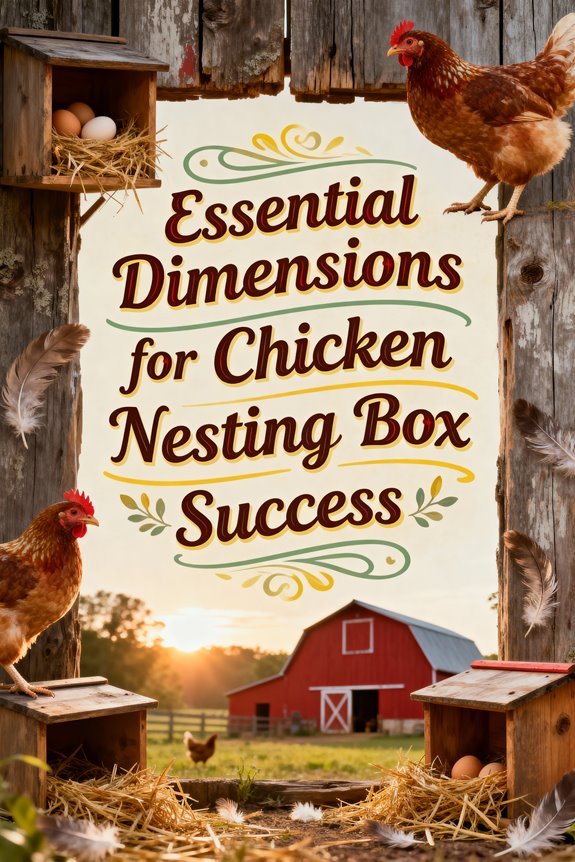Essential Dimensions for Chicken Nesting Box Success
For ideal egg production, you’ll need nesting boxes sized 12″x12″x12″ for standard breeds, 14″x14″x14″ for larger breeds, and 10″x10″x12″ for bantams. Mount boxes 18-20 inches off the floor in darker areas, with a 4-inch front lip to prevent egg rolling. Provide one box per 4-5 hens, ensuring a minimum of two boxes regardless of flock size. Your design should include proper ventilation, sloped roofs, and easy-access features – key elements that determine your laying success.
Standard Box Measurements for Popular Breeds
When designing nesting boxes for your chickens, proper dimensions are essential for both egg production and hen comfort. Different box varieties accommodate specific breed standards, ensuring your flock has the ideal laying environment.
For standard breeds like Leghorns, you’ll need boxes measuring 12″ × 12″ × 12″, while larger breeds such as Orpingtons require 14″ × 14″ × 14″ spaces. If you’re keeping bantams, scale down to 10″ × 10″ × 10″ dimensions. Don’t forget to include a 4″ front lip to prevent eggs from rolling out and install a landing rail 6″ from the entrance. A hen typically spends 25 minutes laying each egg, so proper sizing prevents overcrowding.
These precise measurements prevent multiple hens from sharing boxes while providing enough room for your chickens to turn comfortably and lay eggs securely. The right dimensions create a dark, cozy environment that encourages consistent laying habits. Building with plywood and 2×4 lumber provides a sturdy structure that can be easily customized to accommodate your specific flock size and coop configuration. Consider building a 2×4 supporting frame if you plan to install suspended boxes, which can help maximize coop space and improve accessibility for egg collection.
Customizing Box Sizes for Your Flock
Although standard nesting box dimensions work for many flocks, customizing your boxes’ measurements to match your specific breeds guarantees ideal laying conditions. For larger breeds like Orpingtons, you’ll need boxes at least 14″ deep by 16″ wide, while bantams can thrive in spaces smaller than the typical 12″ cube. Consider your flock’s size when determining the number of boxes – plan for one box per 4-6 hens to prevent overcrowding.
The box shape should accommodate comfortable turning while discouraging multiple occupancy. If you’re managing a larger flock, consider multi-compartment designs with rollaway features to protect eggs. Remember to account for adequate nesting material depth when finalizing your dimensions, and ascertain the interior height allows hens to move naturally while laying. Providing a minimum of two boxes regardless of flock size helps prevent competition and reduces stress among hens. Wall-mounted boxes offer superior cleaning access while preserving valuable floor space in your coop. Supplementing your nesting box setup with homemade chicken treats can help reduce boredom and keep your flock entertained when they’re not laying.
Optimal Height and Placement Strategy
Strategic height placement of nesting boxes plays a critical role in maintaining a healthy, productive flock. You’ll want to position your boxes 18-20 inches off the floor, guaranteeing they’re lower than your roosting bars to prevent overnight nesting. This nesting box height strikes the perfect balance between accessibility and protection from ground-level threats. Consider installing a soft landing area below each box to prevent injury when hens jump down.
When considering positioning factors, mount boxes in darker, quieter areas of your coop, preferably under windows. You’ll need to space multiple boxes appropriately to minimize competition between hens. For young pullets, start boxes at ground level and gradually raise them as they mature. Since many hybrid hens like ISA Browns begin laying as early as 16-22 weeks of age, proper nesting box setup during this critical period ensures your flock establishes good laying habits from the start. Adding a perch for easy access near the entrance allows hens to comfortably enter and exit the nesting area. Remember to account for litter depth in your measurements and guarantee smooth edges around box openings to prevent injury. Secure mounting to walls or platforms is essential for stability and safety.
Key Design Features for Maximum Comfort
Creating comfortable nesting boxes requires careful attention to essential design features that directly impact laying behavior and egg production. For ideal nesting aesthetics, you’ll need to install a raised lip at the front to prevent eggs from rolling out, and add comfort enhancements like soft bedding materials or AstroTurf pads. Include an exterior perch for easy entry and incorporate privacy curtains to create the dim environment hens prefer. The vinyl curtains included with the box provide additional protection while maintaining the desired dark atmosphere hens need for laying.
Your design should feature smooth, cleanable surfaces and a sloped or rollaway floor to keep eggs clean. Install removable trays for efficient maintenance, and guarantee proper ventilation to maintain air quality. Don’t forget to add a protective roof to prevent roosting above the boxes. Using pocket holes and screws along with wood glue ensures sturdy construction that can withstand daily use. Choose durable, non-toxic materials that will withstand frequent use while keeping your hens safe and comfortable. Whether you’re raising chickens for backyard eggs or managing domesticated fowl on a larger scale, proper nesting box design remains essential for optimal egg production.
Getting the Numbers Right: Box-to-Hen Ratio
Beyond the physical design of nesting boxes, proper calculation of box quantities directly impacts your flock’s laying success. The standard ratio you’ll want to maintain is one box per 4-6 hens, though you should always provide at minimum two boxes regardless of flock size. This guarantees adequate space while accounting for your hens’ natural box preferences and laying habits.
Don’t worry about having too many boxes – it’s better to have extra than too few. Insufficient boxes can lead to nest crowding, floor-laid eggs, and aggressive behavior among your hens. While you might notice your flock favoring certain boxes over others, maintaining the proper ratio helps prevent stress and egg damage. For prime results with high-producing breeds or broody hens, consider adding a few extra boxes beyond the baseline recommendation. Since most losses occur at night when hens are roosting or nesting, ensuring your boxes are within a secure coop protected from predators is equally important for your flock’s safety and productivity. This preference pattern is quite common, as studies show hens typically use only 2-3 boxes even when provided with many more options. Providing appropriate nesting pads inside your boxes helps ensure egg safety and creates a comfortable environment that keeps hens calm and content during laying.
Smart Layout Planning for Happy Hens
While planning your nesting box layout, you’ll need to focus on location and positioning to maximize your hens’ comfort and egg production. Select a quiet, dimly lit area away from feeders and waterers, as this aligns with natural hen behavior. Mount boxes approximately 18 inches off the ground, but always below roosting bars to prevent soiling. Plan for one box per 4-5 hens to ensure adequate space for your flock.
Arrange boxes in a single row, avoiding multi-level configurations that can trigger competition. Include a perch or landing bar in front of each box, and add a protective lip to keep eggs secure. Install sloped roofs at 45 degrees to discourage roosting on top. Larger spaces than these minimums help reduce stress and health issues among your hens, promoting better egg-laying consistency. When designing your setup, consider whether to build from scratch or invest in ready-made models that often feature convenient access points and mobility options. For ideal functionality, verify your nesting box layout incorporates easy access for cleaning and egg collection, preferably through external doors or hinged tops.
Critical Construction Elements
The structural foundation of your nesting box begins with careful material selection and proper assembly techniques. You’ll want to use untreated wood, particularly cedar for its natural weather resistance, and create a sturdy frame with 2×4 lumber. Secure your joints using pocket holes and 2.5″ screws rather than nails for lasting durability. Allow one box per 4 hens when planning your overall design.
Incorporate essential construction techniques like reinforced corners and seams to prevent warping. Your design should include ventilation holes at the top, drainage at the bottom, and a solid, sloped roof for protection. Install dividers 12 inches apart and add a 4-inch front lip to retain nesting materials. Don’t forget to include a roosting bar 6 inches from the entrance, giving hens a comfortable landing spot while preserving bedding integrity. For those seeking low-maintenance alternatives, plastic nesting boxes offer advantages like easy disinfection with water and resistance to rot or rust. Proper nesting box design helps prevent reproductive issues that can lead to serious health complications in your flock.
Breed-Specific Size Requirements
Selecting proper nesting box dimensions based on your chicken breeds‘ size requirements will greatly impact laying success and comfort. When building boxes, you’ll need to account for three distinct size categories. Bantam boxes should measure 10″ x 10″ x 12″, providing a snug environment that prevents overcrowding. Standard breeds require 12″ x 12″ x 14″ dimensions, allowing comfortable movement during laying. For heavy breed adjustments, increase dimensions to 14″ wide by 12-14″ deep, with heights of at least 14″ to accommodate larger body mass.
Your boxes’ height should align with breed-specific needs, ranging from 12″ for bantams to 16″ for the largest breeds. Remember that properly sized boxes encourage single-hen usage, reduce egg breakage, and promote consistent laying patterns within your flock. Since hens typically begin laying eggs between 18 to 22 weeks of age, having appropriately sized nesting boxes ready before this time ensures a smooth transition into their productive phase. Including a front lip design helps prevent eggs and nesting material from falling out while hens enter and exit the box. If you’re raising Easter Egger chickens, standard dimensions work well for these medium-sized birds known for their colorful egg production.
Maintenance and Bedding Considerations
Maintaining clean and well-bedded nesting boxes stands essential for your chickens’ health and egg production success. You’ll need to choose appropriate bedding types, with kiln-dried pine shavings offering superior pest resistance compared to straw. Combine these with aspen nesting box liners to maximize cleanliness and durability. Include one box per four hens to ensure adequate nesting space for your flock.
Your cleaning frequency should include daily tidying when collecting eggs, removing droppings and feathers to prevent contamination. You’ll want to refresh bedding monthly, but perform deep cleaning every one to two weeks using hot soapy water and animal-safe cleaners. Don’t forget to add food-grade diatomaceous earth and dried herbs to your fresh bedding – they’ll help control pests naturally. Keep the boxes dry and lock chickens out at night to minimize soiling and maintain ideal hygiene.



